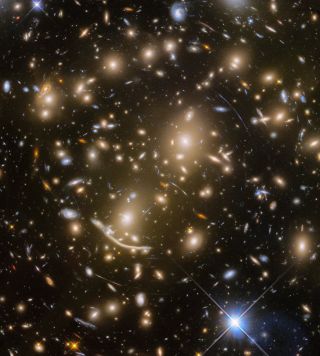Galaxies from a Long Time Ago and Far, Far Away Star in Amazing Hubble View
A remarkable new photo from the Hubble Space Telescope captures an up-close view of some of the earliest and most distant galaxies of the universe.
The photo — taken as part of a new mission called Beyond Ultra-Deep Frontier Fields And Legacy Observations (BUFFALO) — features a massive galaxy cluster named Abell 370, which lies 5 billion light-years from Earth. This galaxy cluster acts as a cosmic magnifying glass, honing in on far-flung objects in the universe.
Hubble is able to detect these otherwise-faint, distant objects because the gravitational force of massive galaxy clusters like Abell 370 bends and magnifies light from the more-distant objects in the background — a natural phenomenon also known as strong gravitational lensing. [Wow! Hubble Snaps Super-Deep View of Universe (Photos)]

The new Hubble image revealed numerous galaxies that reside far beyond Abell 370. It also captured a feature nicknamed "the Dragon," which can be seen just below the center of the galaxy cluster. This feature actually consists of several duplicated images of a single background spiral galaxy stretched along an arc, according to a statementfrom the Hubble Space Telescope.
As part of the BUFFALO survey, the Hubble telescope will observe six massive galaxy clusters and their surroundings. The new data will help astronomers learn more about the evolution of the earliest galaxies in the universe.
This project succeeds the Frontier Fields program, which ran from 2013 to 2017. During that program, Hubble probed six notable galaxy clusters that all showed effects of strong gravitational lensing, according to the statement.
Following its predecessor's achievement, BUFFALO will investigate how and when the most massive and luminous galaxies in the universe formed, as well as the link between dark matter and galaxies that formed in the first 800 million years after the Big Bang.
Get the Space.com Newsletter
Breaking space news, the latest updates on rocket launches, skywatching events and more!
"Driven by the Frontier Fields observations, BUFFALO will be able to detect the most-distant galaxies approximately 10 times more efficiently than its progenitor," according to the statement. "The BUFFALO survey will also take advantage of other space telescopes which have already observed the regions around the clusters. These data sets will be included in the search for the first galaxies."
Data collected from the BUFFALO project will also benefit upcoming missions like NASA's James Webb Space Telescope, which is scheduled for launch in 2021 and is set to replace the Hubble telescope.
Follow Samantha Mathewson @Sam_Ashley13. Follow us @Spacedotcom, Facebook and Google+. Original article on Space.com.
Join our Space Forums to keep talking space on the latest missions, night sky and more! And if you have a news tip, correction or comment, let us know at: community@space.com.

Samantha Mathewson joined Space.com as an intern in the summer of 2016. She received a B.A. in Journalism and Environmental Science at the University of New Haven, in Connecticut. Previously, her work has been published in Nature World News. When not writing or reading about science, Samantha enjoys traveling to new places and taking photos! You can follow her on Twitter @Sam_Ashley13.
